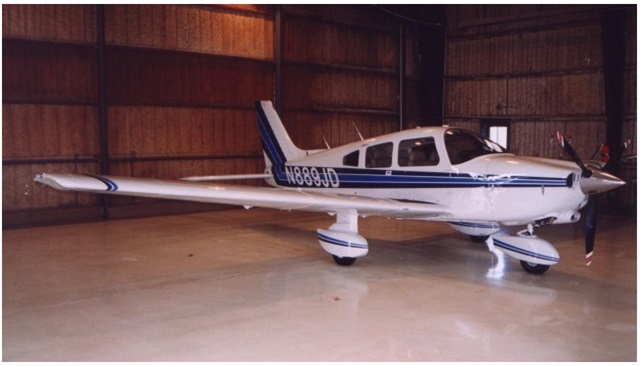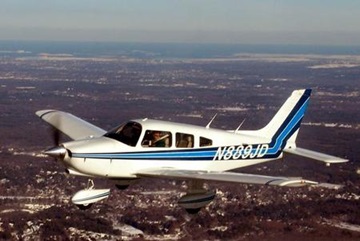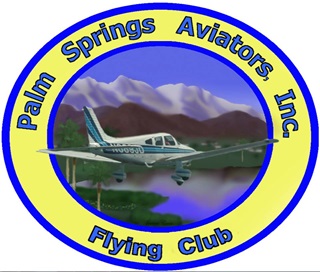
Brian Carr relocated from the East Coast to Palm Springs. He owned a 1981 Piper Dakota with a partner and they shared the airplane – six months out east, six months out west. The situation wasn’t ideal.
Kent Pramhus ran a for-profit flight club with 10 airplanes in the LA area. The business also was a sales brokerage, leasing company, and repair shop. He sold the business a few years ago and moved 100 miles east to what was then his vacation home in Palm Springs to live full time.
Brian was looking to form a flying club. Kent was looking to have access to a quality airplane.
“Brian and I got to talking, we belong to the same golf club, and we said let’s try to meld the two ideas,” Kent said. “Our ultimate goal was to have an airplane we could use and share with people and help make the cost of flying cheaper. Our requirements were it had to be a capable aircraft that was nice and clean and well maintained.”
And that’s basically how the Palm Springs Aviators, Inc. Flying Club was formed. Brian and Kent found three other pilots who were interested in a club, spent a few months hammering out bylaws and in December 2014, the club was incorporated.
Club membership includes a $500 non-refundable joining fee and monthly dues of $89 that pays for the hangar and insurance. The airplane rents for $165 an hour, wet. Brian and Kent worked out the finances figuring the hourly costs include $25 for an engine and prop reserve, $25 for routine maintenance, and 13 gph at $6 a gallon.
“We just ran a pro forma, simple cash flow for going out two years,” Kent said. “When we get to nine members we’re about breaking even and at 12 members we’re getting a little ahead on the numbers.”
They planned for 36 hours of flying per member per year, or three hours per month, and ran numbers out that way.
When the club began, it had five members. Two more have already joined and at the time of writing this article there were another three expected to join in the next few weeks.
Getting Advice From Other Clubs
One of the things Brian and Kent did to start the club was to go to AOPA’s Regional Fly-In in Chino this past September. The short flight was well worth it.
They sat in on the flying club initiative presentation that included members from the A&E Flying Club based at Hawthorne Airport (KHHR) and the Smoke Eagles Flying Club based at Fullerton Airport (KFUL).
“I had never considered doing a not-for-profit. Brian and I had been leaning towards a for-profit model,” Kent said. “But talking to them, listening to them, we figured, why not lets do it that way. So we basically took the A&E bylaws and used them as a basis for ours.”
Getting the bylaws written and adopted was both the most challenging and rewarding thing for Kent. “To take it from an idea through the gestation to actually launching and getting members signed off and using the airplane, that to me is absolutely rewarding,” Kent said.
But it wasn’t without some challenges. As a business owner he is used to making a decision and moving forward. With a non-profit with a board, building consensus before taking action is a slower process, but an important step that was new for Kent.
However, it helped him put into practice some sound business advice he has always employed. “The thing I found from running a business is if you make your employees feel valuable, if you make your members take ownership of their own club, they will do whatever they can to make the club successful,” Kent said.
It’s all About Timing: Media and Marketing Success
 With the club formed and operating, the first thing to do was focus on building membership. One of the club members, Mitch Spike, is a retired police officer and was the public information officer for the Palm Springs Police Department, which presented an excellent opportunity for him take on a project. Using his media contacts, the club has had two TV news stories and two print articles already.
With the club formed and operating, the first thing to do was focus on building membership. One of the club members, Mitch Spike, is a retired police officer and was the public information officer for the Palm Springs Police Department, which presented an excellent opportunity for him take on a project. Using his media contacts, the club has had two TV news stories and two print articles already.
“We’ve had some really good media attention out here. A couple news stations came out and did some stories on us. The Desert Sun did an article on us and we got tremendous response,” Kent said. “We coupled all that with a direct mailing. We downloaded the FAA database and culled it down to about 600 pilots in the area and did a postcard mailing to them.”
The timing was perfect. The news broadcasts were spread over two weeks and then Desert Sun article came out a week after that. “We had good solid media pops and we coupled that with putting something in their hands to call,” Kent said. “We had a really good response. We’ve gotten a good buzz among aviators here in the valley.”
The takeaway here was having the relationships with the media, or making the effort to build the relationships. Kent had sent out a bunch of inquiries to the press with little success, but when Mitch, the retired police officer and club secretary, used the relationships he had with the media, several stories followed.
“We’ve gotten three more members in the club because of that mailing and media attention,” Kent said. “We’re effectively going to double the size of our club through the marketing and media efforts. That’s critical.”
Takeaways
The big takeaways for the Palm Spring Aviators are solid bylaws, leverage the resources you have, and setting small goals to move toward the larger ones.
For Kent putting in the effort in to build the club foundation with good bylaws was critical. It’s not always easy, but the process will build a strong leadership team and protect the club in years to come as membership increases. “We’re in the honeymoon period where everybody loves each other,” Kent said. “But when you add members down the road and different personalities come in, you need a good set of guiding principles.”
The next lesson is to leverage the resources in your club, like having Mitch handle the media outreach because of his experience. Through his relationships he was able to generate positive media and that is where the new members have come from.
The third lesson is do more than just talk about the club. “You really need to take action and keep moving forward. Set mini milestones. I’m a big believer in lists and checklists for everything,” Kent said. “You’ve got to set these intermediate targets to get to your big targets. By setting those intermediate targets and keeping everybody appraised, you can show the progress and keep moving things forward.”
And lastly, just talk about what you’re doing and invite people to participate. Kent met Mitch on the golf course. They began talking, “he said, ‘I’m a pilot’, so I handed him a business card and told him we were just forming this club and he jumped on board,” Kent said. “You just have to talk to people and it’s amazing. Those are my words of wisdom.”
Factsheet
|
Name |
Palm Springs Aviators Inc. Flying Club |
|
Location |
Palm Springs International Airport (KPSP), Palm Springs, CA |
|
Website |
|
|
Year formed |
2014 |
|
Aircraft |
1981 PA-28-236 Piper Dakota ($165/hr) |
|
Joining fee |
$500 non-refundable fee |
|
Monthly dues |
$89 per month |
|
Membership |
10 |
|
Scheduler |
Flight Circle www.flightcircle.com |